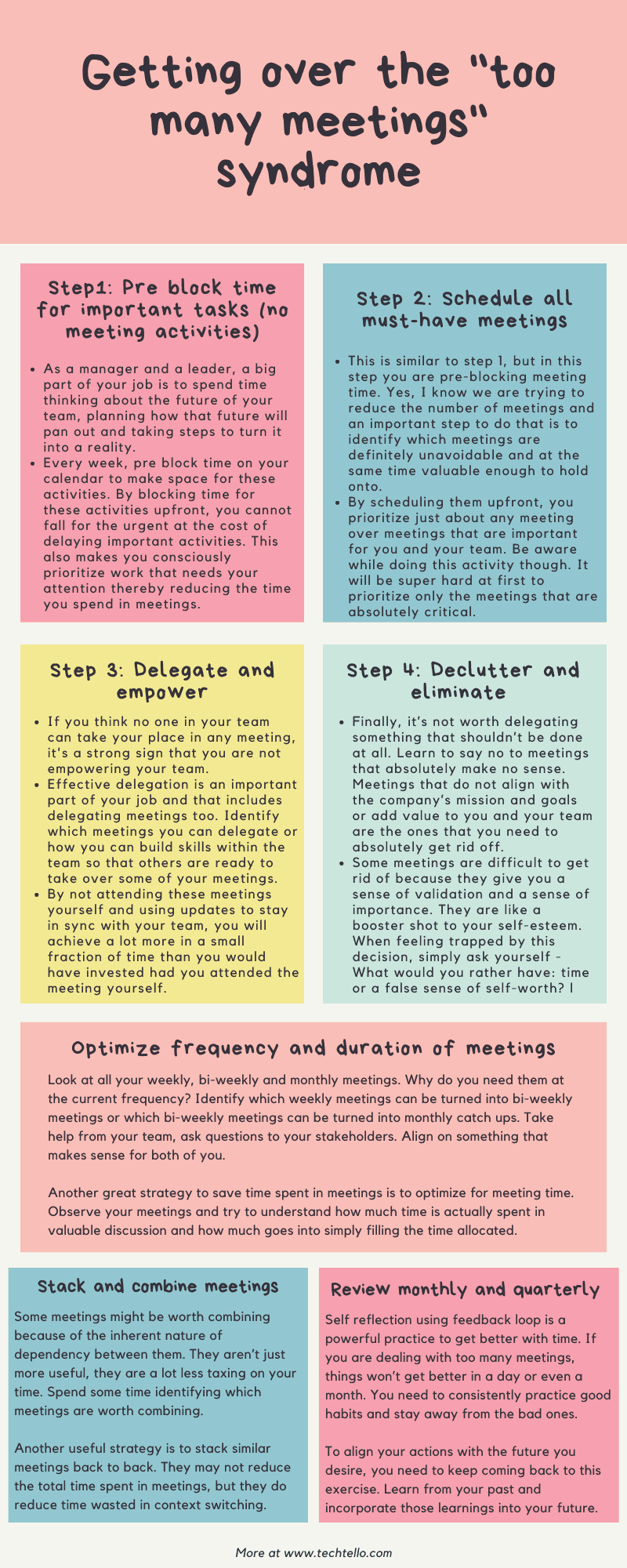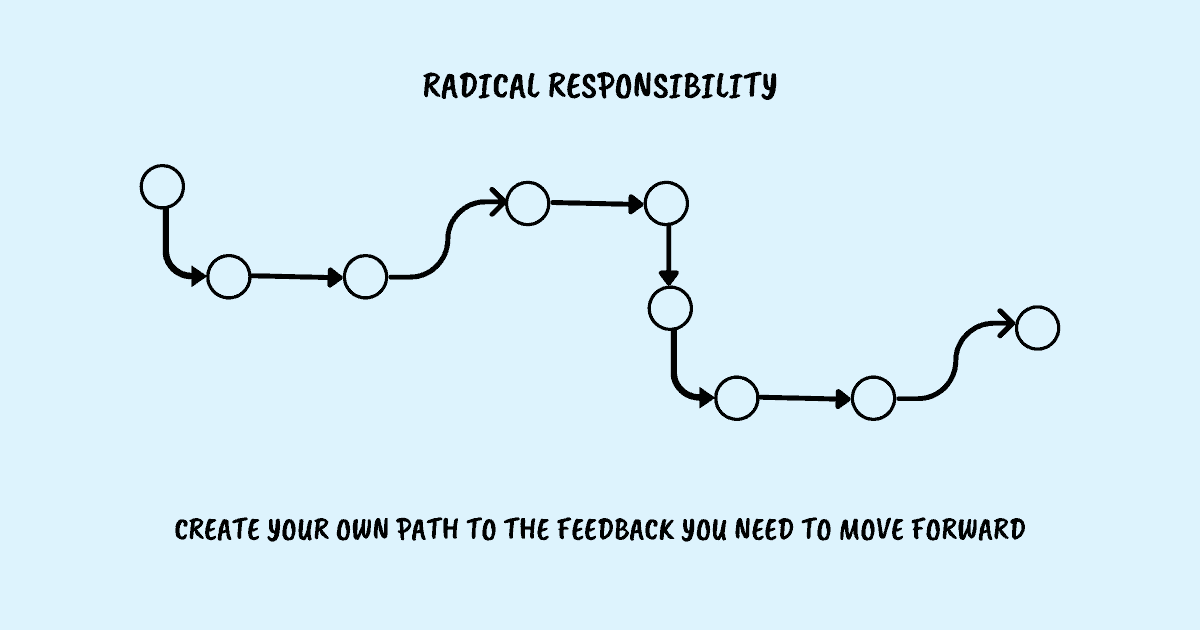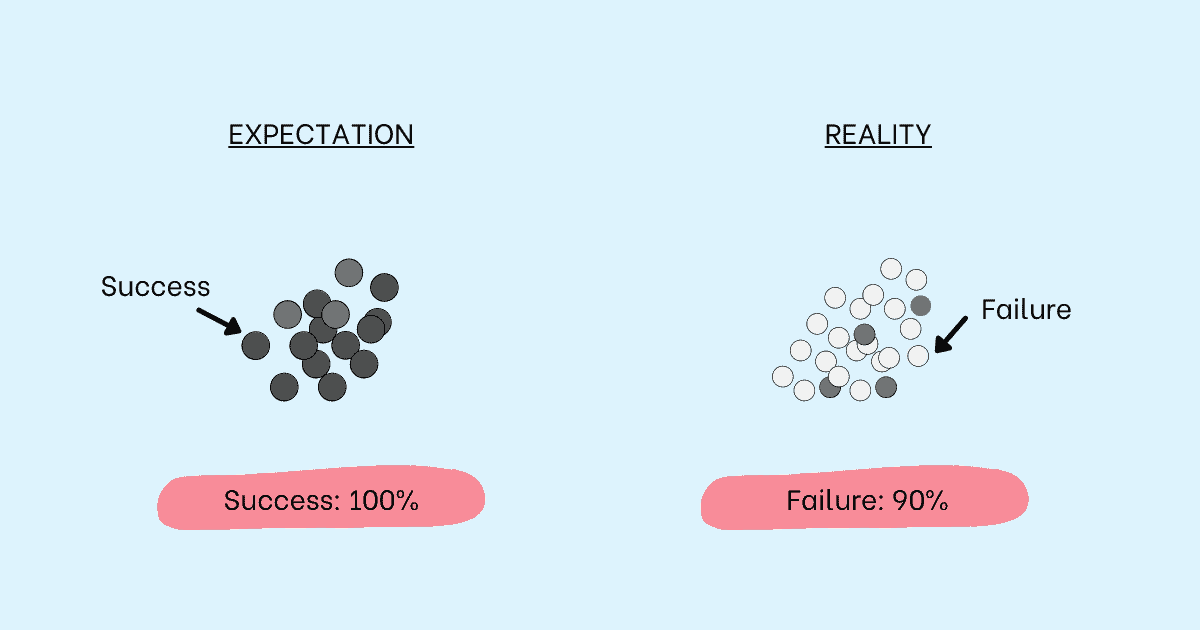Too Many Meetings At Work? Here’s How to Stop the Meeting Madness

Too many meetings. I had said those three words way too many times that month. Sometimes as a fleeting comment to myself. Other times in the form of self-pity as this excessive, self-absorbed unhappiness over the current state of my work.
Instead of shouting at the top of my lungs and getting myself out of the rut I had fallen into, I simply accepted it as a way of life “this is how it’s supposed to be and I can’t really do much about it.” After all, I consciously opted in to be a manager and way too many meetings somehow seemed like a part of a manager’s job.
A few months passed by and then things got worse. My scope increased, my team size more than doubled and so did the number of meetings. I absolutely lost control over my time. I was in a constant state of frenzy throughout the day moving from one meeting to the next only to be left exhausted, disoriented and grumpy.
I loved my organization and my team. But I didn’t feel so great about my work. Too many meetings had become an easy escape and excuse to avoid the things that demanded my time and attention – planning for the future, identifying better opportunities for my team, or investing in my own learning.
I was often left wondering at the end of the day if I added any real value that day. Yes, I was leading a lot of great projects at work, but I didn’t feel effective in my job. And not feeling effective in my work left me feeling burnt out.
I had let the “too many meetings” and “this is a manager’s life” excuse go on for too long. It was time for me to be real. To take one hard look at my life and face the reality of my situation. I wanted to get over my own nonsense and start putting some sense into my work.
The process started with a simple goal – Take back control of my time to do work that adds value.
Make Time is a framework for choosing what you want to focus on, building the energy to do it, and breaking the default cycle so that you can start being more intentional about the way you live your life — Jake Knapp, Make Time
Ofcourse, optimizing the time spent in meetings was a very big component of meeting this goal. That’s where I started. I decided to start with small changes to avoid going back to my default mode with fear of how it will all work out.
Every week, I would look at my calendar and ask these questions to myself:
- How will I add value to this meeting?
- What can I expect to learn from this meeting?
- Is there anyone else who can take my place?
- What will happen if I don’t attend this meeting?
These simple questions triggered a sense of awareness around meetings instead of my default mode to go with every meeting that showed up on my calendar. I still ended up attending quite a lot of them, but a feeling of control over my schedule energized me to take this process to the next level.
I decided to go all-in and created a step-by-step process that anyone can use to get a better handle over their time by stopping using meetings as a way to fill time and start generating value.
Getting over the “too many meetings at work” syndrome
If you aren’t aware of the Eisenhower Urgent/Important Matrix, I suggest you first establish a basic understanding of the framework. This framework will be super useful when you get down to actually implementing the strategies outlined below.
Step1: Pre block time for important tasks (no meeting activities)
Important tasks generate long term value for you and your organization. They are high leverage activities that will push your team and your organization to the next level.
As a manager and a leader, a big part of your job is to spend time thinking about the future of your team, planning how that future will pan out and taking steps to turn it into a reality. No one else in the team can do this.
The first practice is to ask what needs to be done. Note that the question is not “What do I want to do?” Asking what has to be done, and taking the question seriously, is crucial for managerial success. Failure to ask this question will render even the ablest executive ineffectual — Peter Drucker, The Effective Executive
Every week, pre block time on your calendar to make space for these activities. By blocking time for these activities upfront, you cannot fall for the urgent at the cost of delaying important activities. This also makes you consciously prioritize work that needs your attention thereby reducing the time you spend in meetings.
Step 2: Schedule all must-have meetings
This is similar to step 1, but in this step you are pre-blocking meeting time. Yes, I know we are trying to reduce the number of meetings and an important step to do that is to identify which meetings are definitely unavoidable and at the same time valuable enough to hold onto. At this stage, if you aren’t sure about any meeting, just park them.
All meetings are not really a waste of time. If you are a manager or a leader, meetings like one-on-one, skip-level, stakeholder updates, and staff meetings are actually quite valuable.
By scheduling them upfront, you prioritize just about any meeting over meetings that are important for you and your team. Be aware while doing this activity though. It will be super hard at first to prioritize only the meetings that are absolutely critical. To avoid falling into the trap where you end up squeezing everything into your calendar, use the strategy from step 3.
Step 3: Delegate and empower
It is easy to believe that you and only you are best suited to be part of a meeting and no one else can take your place. Partly right and a whole lot wrong.
Yes, others cannot take your place. But, the question you need to ask yourself is not whether someone can replace you. Instead, you need to ask:
- Who can do a good enough job in the meeting?
- Who can you trust with more responsibilities?
- Who is ready to make such decisions?
If you want to do a few small things right, do them yourself. If you want to do great things and make a big impact, learn to delegate — John C. Maxwell, Developing the Leaders Around You.
If you think no one in your team can take your place in any meeting, it’s a strong sign that you are not empowering and enabling your team. You are the bottleneck of decision making within your team and that’s pushing your team towards mediocrity instead of driving them towards excellence. Empowering employees not only frees up a significant portion of your time, it creates a healthy work environment as employees feel happy to be trusted by their managers.
Effective delegation is an important part of your job and that includes delegating meetings too. Identify which meetings you can delegate or how you can build skills within the team so that your team members are ready to take over some of your meetings.
By not attending these meetings yourself and using updates to keep yourself in sync with your team, you will achieve a lot more in a small fraction of time than you would have invested had you attended the meeting yourself.
Step 4: Declutter and eliminate
Finally, it’s not worth delegating something that shouldn’t be done at all. Learn to say no to meetings that absolutely make no sense. Meetings that do not align with the company’s mission and goals or add value to you and your team are the ones that you need to absolutely get rid off.
Some meetings are difficult to get rid of because they give you a sense of validation and a sense of importance. They are like a booster shot to your self-esteem. When feeling trapped by this decision, simply ask yourself – What would you rather have: time or a false sense of self-worth?
These meetings aren’t simply worth your time. You are better off without them and your team is definitely going to be a lot better when you invest time and energy in doing things that matter in the long run.
Daily Weekly Monthly Planner Worksheets
Manage your to-do list, stay productive and cultivate healthy life habits with these planners.
Other strategies for managing meeting time well
By applying the strategies above, you will be able to reduce meeting time significantly. However, you are not done yet. There’s so much more you can do to reclaim your valuable time:
1. Optimize frequency and duration of meetings
Do you really need one-on-one with every member of your team every week? What if it’s bi-weekly? What value does a weekly meeting provide over a bi-weekly meeting? What value does a bi-weekly meeting provide over a monthly one?
Look at all your weekly, bi-weekly and monthly meetings. Why do you need them at the current frequency? Identify which weekly meetings can be turned into bi-weekly meetings or which bi-weekly meetings can be turned into monthly catch ups. Take help from your team, ask questions to your stakeholders. Align on something that makes sense for both of you.
Another great strategy to save time spent in meetings is to optimize for meeting time. Observe your meetings and try to understand how much time is actually spent in valuable discussion and how much goes into simply filling the time allocated.
According to Parkinson’s Law, work expands to fill the time allotted for its completion. This applies to meetings too.
2. Stack and combine meetings
Some meetings might be worth combining because of the inherent nature of dependency between them. They aren’t just more useful, they are a lot less taxing on your time. Spend some time identifying which meetings are worth combining.
Another useful strategy is to stack similar meetings back to back. They may not reduce the total time spent in meetings, but they do reduce time wasted in context switching.
E.g. Instead of doing just one 20 mins 1-1, it might be useful to do two of them back to back. Your brain rhythm set using the first 1-1 meeting will make the second one go much easier.
Once you start using stacking as an approach, your meetings will be automatically optimized inherently demanding that you apply strategy #1 – reduce the time of these meetings.
3. Review monthly and quarterly
Self reflection using feedback loop is a powerful practice to get better with time. If you are dealing with too many meetings, things won’t get better in a day or even a month. You need to consistently practice good habits that will keep you away from falling for the bad ones.
You can’t do this whole exercise just once. You aren’t done yet. To align your actions with the future you desire, you need to keep coming back to this exercise. Learn from your past and incorporate those learnings into your future. Look at the calendar for the last month and ask:
- Where did I spend most of my time?
- How many of those meetings were actually useful?
- Why did I end up attending meetings that seemed like a mistake later?
- What can I do more to reduce time spent in meetings?
- What can I do less to reduce time spent in meetings?
Doing this exercise regularly will keep you sane while actually doing work that will add value to your life and the people around you. Next time you find yourself saying “too many meetings,” take a pause, let the words sink in and immediately schedule a time on your calendar to repeat the strategies outlined here. All the best!
Ending with this thought from Cal Newport, Deep Work “Your goal is not to stick to a given schedule at all costs; it’s instead to maintain, at all times, a thoughtful say in what you’re doing with your time going forward.”
Meeting Minutes Template
Keep track of key decisions, action items and other takeaways from the meeting with this worksheet.
Summary
- If you find yourself saying “too many meetings,” don’t assume it’s a part of your job. You are probably attending meetings that don’t add value to you and your team.
- You need to manage your own time better, and that includes time spent in meetings. No one else can do it for you.
- To start, every week pre-block no meeting time on your calendar for important activities like future planning for your team. By blocking this time upfront, you will end up spending less time in meetings while doing work that will push you and your organization forward.
- Next step is to make space for meetings that are absolutely critical for your team like one-on-one, stakeholder updates, staff meetings etc. By scheduling them upfront, you leave less room for inconsequential meetings.
- Identify which meetings can be delegated to your team members. By empowering your team to make decisions on their own, you not only reduce the time spent in meetings, but also promote a happy and healthy work environment.
- Finally, declutter your calendar and eliminate meetings that shouldn’t be done at all. These meetings may boost your self esteem, but they do nothing to advance you and your team in the direction of your goals.
- Once you have a handle over these strategies, take a step further and reclaim more time by optimizing for frequency and duration of meetings, combining and stacking meetings and making a habit to review your progress every month and every quarter. Self reflection is a powerful technique to learn from your past and design a better future for yourself and the people around you.






























